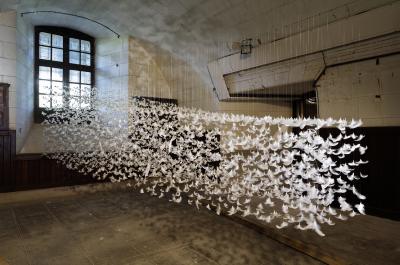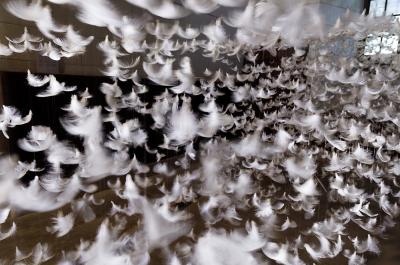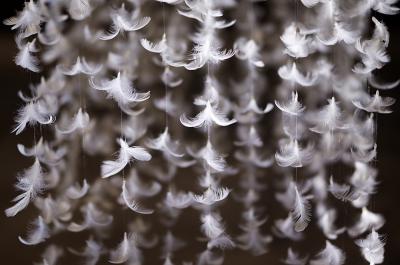Office, Château
A. Isa Barbier
“Faisceau”
published at 27/01/2020

Isa Barbier's work primarily derives from encountering, comprehending and interpreting a place. It is often site-specific to somewhere such as a chapel, castle, convent or seafront, but it could also be a more traditional museum or art gallery. The uniqueness of the location determines the appearance of the artwork.
Isa Barbier therefore mostly works in situ, displaying installations made of light, airy materials such as feathers, petals or mirrors arranged in geometric, architectural or dynamic forms. Her works appear to float in thin air.
As well as the suspended objects themselves, light, breath and air must be considered as fluctuating elements that contribute to the perception of the work and the way it floats.
The effect of these external elements is not incidental, it enhances the artistic endeavour just as much as the work itself. Thus Isa Barbier’s lively aerial installations never cease to reinvent themselves.
A different relationship with the work
“An installation of feathers is a nebulous object that can’t even be captured by photography. Its memory is always failing, sketchy and one-sided. These airy sculptures only appear to be fragile. An appropriate place away from disturbances, and simple and patient care and attention can make them last a lot longer than you would expect.
The threads can be untangled, the wax can be checked between two fingers, and the feathers can be replaced or washed. This maintenance is a pleasure, but also a constraint. To end it, you can dismantle the work. In which case this large volume is reduced to a handful of feathers that can be placed in a “box or urn”. Later, the work can be reinterpreted in the same place using the 'score' and the feathers just waiting to be reused. The work floats between disappearance and continuity. Its life depends on our actions. You must dare to touch it, delicately, patiently, gently in order to keep it alive, but also accept that the work will end, either on a day of choice or one which arrives by accident. And you must find in this ending beauty and freedom. A new space. To be in front of this suspended life, so vulnerable and therefore so precious, is like being in front of our life.” Isa Barbier
“Her feathers are all alike yet so different. False fractals. Like a number of similar elements, none of which are identical and all of which can be infinitely reconstructed. You can believe that she sees the particles dancing in rays of sunlight, and that, having an eye for it, she makes herself the messenger of the natural order, born by chance and of necessity.
Isa Barbier offers a world with the potential both for extension and obliteration. This movement is so volatile, this wave that disturbs the lines, this wind that deforms or breaks the body of her works, this sculpture of emptiness that does not fear nothingness brings us back to the space found between things, rather than the things themselves. Through her work she describes the idea of a shifting shape, as tenuous as it may be; which by moving, dispels the mirage of an eternal state, indissoluble, suspended in the world of ideas.
Like a footprint in the sand, this work effortlessly abandons the concept of death. And its weightlessness is caused not only by feathers, leaves or threads themselves, but also due to her method, which uses nothing that is not already there: remains fallen from the sky, reunited and linked to a place with a long history, perhaps a castle or a chapel. Nothing is removed from the world, nothing – or very little – is added, but the whole body is arranged differently. Isa Barbier appears to glide into the spaces that she works in, without damaging them.” Christine Rodès, June 2012
BIOGRAPHICAL NOTES
Isa BARBIER
FRANCE


Born in 1945 in Cannes, Isa Barbier is a French artist who lives and works in between Marseille and Italy. She enrolled at the École Nationale Supérieure des Arts Décoratifs in Nice in 1966 and later gained a joint honours degree in history and the history of art and archaeology from the Université d’Aix-en-Provence in 1971. This enabled her to spend ten years of her life, between 1970 and 1980 working on archaeological digs, however, this did not prevent her from also gaining a diploma in psychology in 1973. From 1980 onwards she devoted herself to sculpture and drawing. She belatedly gained a masters in visual arts in 1993.
In collecting the material for her works – natural objects found on the ground, she steps back into her childhood days when she would accompany her botanist father in his hunt for plants and insects, both of them passionate about natural sciences.
In the first monograph dedicated to her work, published by Éditions Lienart in 2017, Nathalie Ergino identified four types of work in the artist's creations: drawings on paper, wall reliefs, site-specific installations and microstructures.


